A Detailed Analysis of Computer Networks: From Basics to Topologies
VerifiedAdded on 2022/09/05
|11
|2903
|28
Report
AI Summary
This report provides a comprehensive overview of computer networks, beginning with the fundamental concepts and uses of networks, such as file sharing, application sharing, and communication. It then delves into the tasks of a network, highlighting its importance in modern environments and detailing the advantages and disadvantages of network implementation. The report further classifies networks based on their characteristics, differentiating between Local Area Networks (LANs) and Wide Area Networks (WANs), and explores various network models, including peer-to-peer and client-server architectures, outlining their criteria, advantages, and disadvantages. Additionally, it covers different types of networks like LAN, MAN, and WAN, and the role of computer networks in the modern world. Finally, the report discusses network topologies and their significance.

Contents
NETWORK....................................................................................................................................................1
uses of network.......................................................................................................................................2
tasks of a network...................................................................................................................................2
advantages of networks..........................................................................................................................3
Disadvantages of networks......................................................................................................................3
Network Characteristics..........................................................................................................................3
Network Models Peer to Peer and Client and Server..............................................................................4
PEER TO PEER NETWORKS...................................................................................................................4
Criteria for selecting peer to peer........................................................................................................5
CLIENT SERVER NETWORK.......................................................................................................................6
Types of network.....................................................................................................................................6
LAN......................................................................................................................................................7
MAN....................................................................................................................................................7
WAN....................................................................................................................................................8
Network Topologies................................................................................................................................8
The Role of Computer Networks in Modern World.....................................................................................9
How network used in old ERA...............................................................................................................10
The network used during and after corona...........................................................................................10
NETWORK....................................................................................................................................................1
uses of network.......................................................................................................................................2
tasks of a network...................................................................................................................................2
advantages of networks..........................................................................................................................3
Disadvantages of networks......................................................................................................................3
Network Characteristics..........................................................................................................................3
Network Models Peer to Peer and Client and Server..............................................................................4
PEER TO PEER NETWORKS...................................................................................................................4
Criteria for selecting peer to peer........................................................................................................5
CLIENT SERVER NETWORK.......................................................................................................................6
Types of network.....................................................................................................................................6
LAN......................................................................................................................................................7
MAN....................................................................................................................................................7
WAN....................................................................................................................................................8
Network Topologies................................................................................................................................8
The Role of Computer Networks in Modern World.....................................................................................9
How network used in old ERA...............................................................................................................10
The network used during and after corona...........................................................................................10
Paraphrase This Document
Need a fresh take? Get an instant paraphrase of this document with our AI Paraphraser
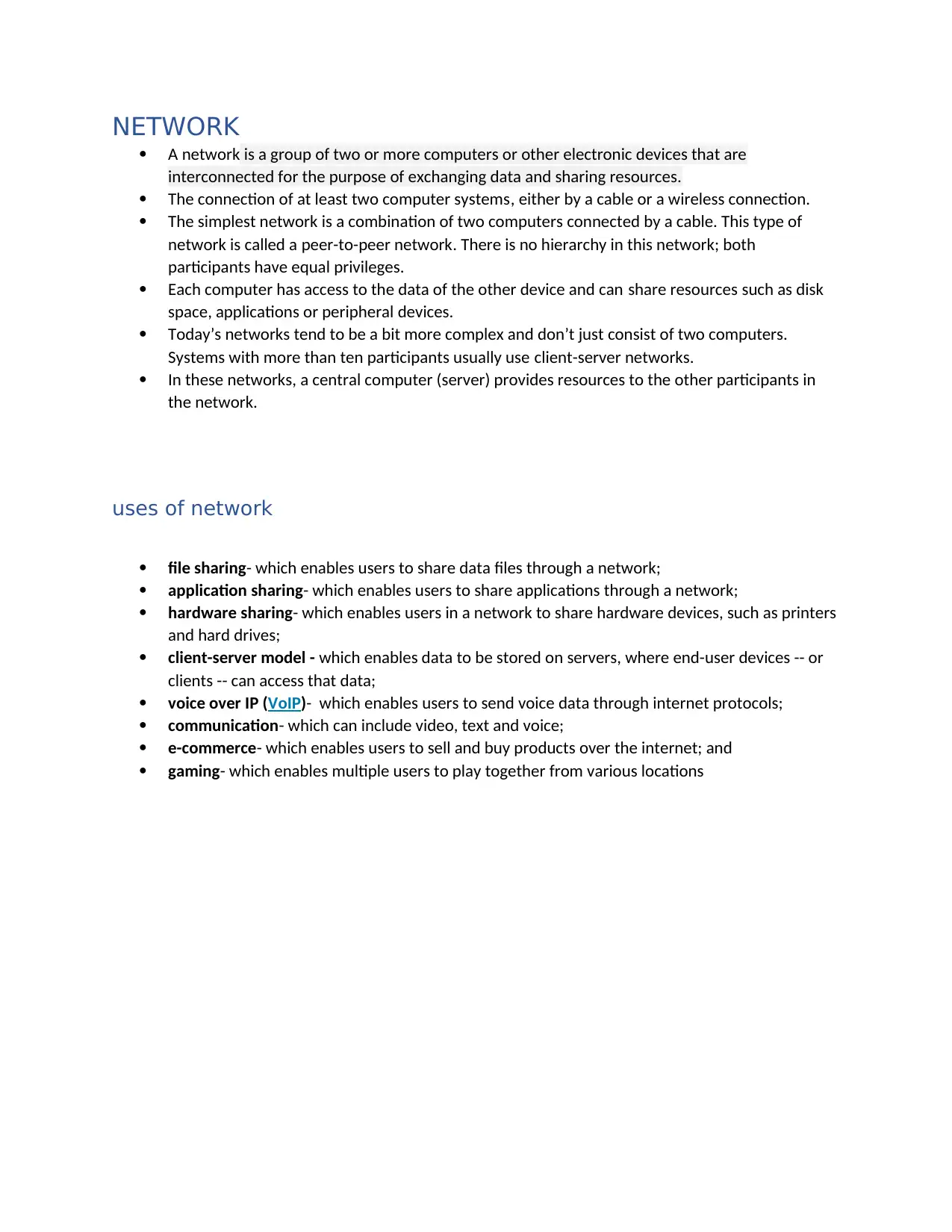
NETWORK
A network is a group of two or more computers or other electronic devices that are
interconnected for the purpose of exchanging data and sharing resources.
The connection of at least two computer systems, either by a cable or a wireless connection.
The simplest network is a combination of two computers connected by a cable. This type of
network is called a peer-to-peer network. There is no hierarchy in this network; both
participants have equal privileges.
Each computer has access to the data of the other device and can share resources such as disk
space, applications or peripheral devices.
Today’s networks tend to be a bit more complex and don’t just consist of two computers.
Systems with more than ten participants usually use client-server networks.
In these networks, a central computer (server) provides resources to the other participants in
the network.
uses of network
file sharing- which enables users to share data files through a network;
application sharing- which enables users to share applications through a network;
hardware sharing- which enables users in a network to share hardware devices, such as printers
and hard drives;
client-server model - which enables data to be stored on servers, where end-user devices -- or
clients -- can access that data;
voice over IP (VoIP)- which enables users to send voice data through internet protocols;
communication- which can include video, text and voice;
e-commerce- which enables users to sell and buy products over the internet; and
gaming- which enables multiple users to play together from various locations
A network is a group of two or more computers or other electronic devices that are
interconnected for the purpose of exchanging data and sharing resources.
The connection of at least two computer systems, either by a cable or a wireless connection.
The simplest network is a combination of two computers connected by a cable. This type of
network is called a peer-to-peer network. There is no hierarchy in this network; both
participants have equal privileges.
Each computer has access to the data of the other device and can share resources such as disk
space, applications or peripheral devices.
Today’s networks tend to be a bit more complex and don’t just consist of two computers.
Systems with more than ten participants usually use client-server networks.
In these networks, a central computer (server) provides resources to the other participants in
the network.
uses of network
file sharing- which enables users to share data files through a network;
application sharing- which enables users to share applications through a network;
hardware sharing- which enables users in a network to share hardware devices, such as printers
and hard drives;
client-server model - which enables data to be stored on servers, where end-user devices -- or
clients -- can access that data;
voice over IP (VoIP)- which enables users to send voice data through internet protocols;
communication- which can include video, text and voice;
e-commerce- which enables users to sell and buy products over the internet; and
gaming- which enables multiple users to play together from various locations
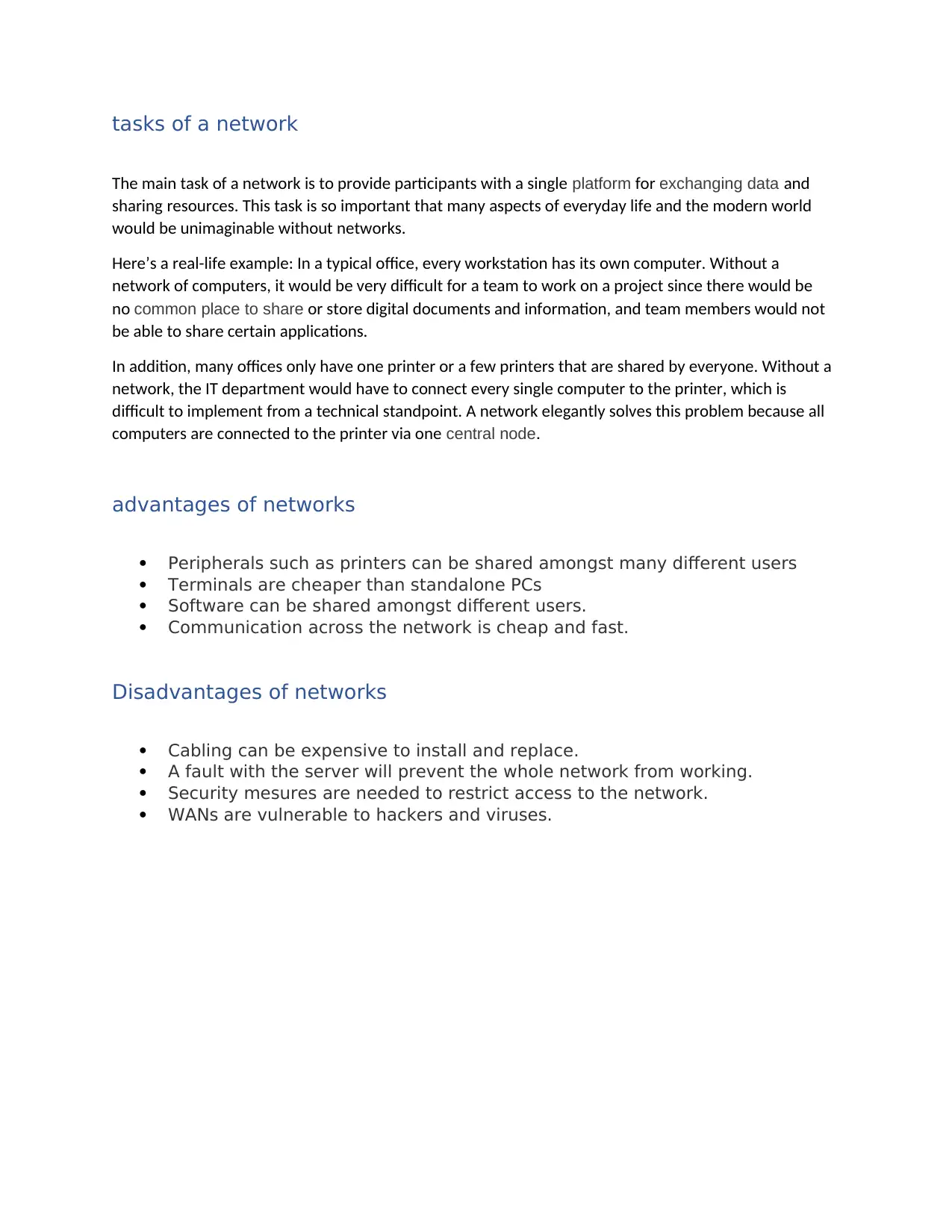
tasks of a network
The main task of a network is to provide participants with a single platform for exchanging data and
sharing resources. This task is so important that many aspects of everyday life and the modern world
would be unimaginable without networks.
Here’s a real-life example: In a typical office, every workstation has its own computer. Without a
network of computers, it would be very difficult for a team to work on a project since there would be
no common place to share or store digital documents and information, and team members would not
be able to share certain applications.
In addition, many offices only have one printer or a few printers that are shared by everyone. Without a
network, the IT department would have to connect every single computer to the printer, which is
difficult to implement from a technical standpoint. A network elegantly solves this problem because all
computers are connected to the printer via one central node.
advantages of networks
Peripherals such as printers can be shared amongst many different users
Terminals are cheaper than standalone PCs
Software can be shared amongst different users.
Communication across the network is cheap and fast.
Disadvantages of networks
Cabling can be expensive to install and replace.
A fault with the server will prevent the whole network from working.
Security mesures are needed to restrict access to the network.
WANs are vulnerable to hackers and viruses.
The main task of a network is to provide participants with a single platform for exchanging data and
sharing resources. This task is so important that many aspects of everyday life and the modern world
would be unimaginable without networks.
Here’s a real-life example: In a typical office, every workstation has its own computer. Without a
network of computers, it would be very difficult for a team to work on a project since there would be
no common place to share or store digital documents and information, and team members would not
be able to share certain applications.
In addition, many offices only have one printer or a few printers that are shared by everyone. Without a
network, the IT department would have to connect every single computer to the printer, which is
difficult to implement from a technical standpoint. A network elegantly solves this problem because all
computers are connected to the printer via one central node.
advantages of networks
Peripherals such as printers can be shared amongst many different users
Terminals are cheaper than standalone PCs
Software can be shared amongst different users.
Communication across the network is cheap and fast.
Disadvantages of networks
Cabling can be expensive to install and replace.
A fault with the server will prevent the whole network from working.
Security mesures are needed to restrict access to the network.
WANs are vulnerable to hackers and viruses.
⊘ This is a preview!⊘
Do you want full access?
Subscribe today to unlock all pages.

Trusted by 1+ million students worldwide
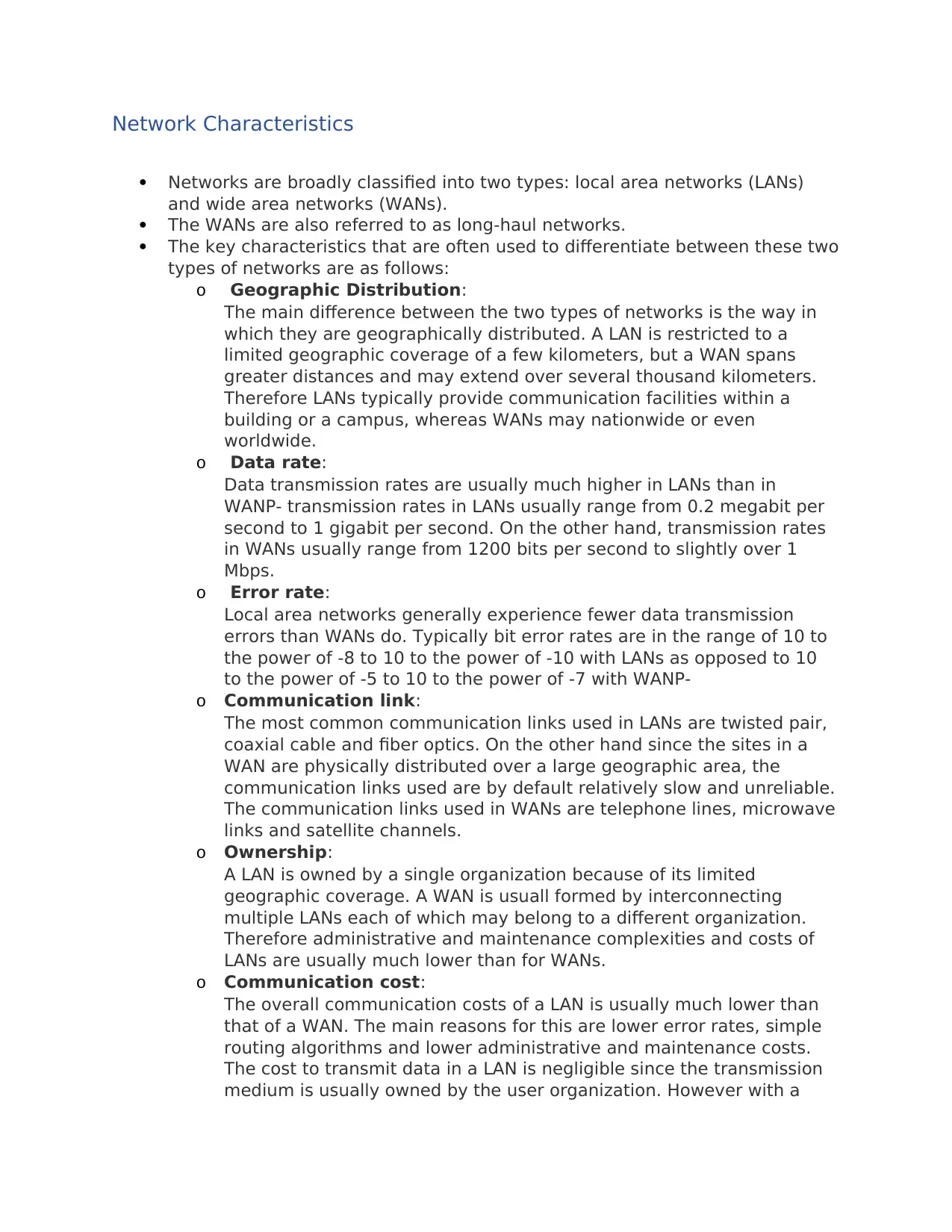
Network Characteristics
Networks are broadly classified into two types: local area networks (LANs)
and wide area networks (WANs).
The WANs are also referred to as long-haul networks.
The key characteristics that are often used to differentiate between these two
types of networks are as follows:
o Geographic Distribution:
The main difference between the two types of networks is the way in
which they are geographically distributed. A LAN is restricted to a
limited geographic coverage of a few kilometers, but a WAN spans
greater distances and may extend over several thousand kilometers.
Therefore LANs typically provide communication facilities within a
building or a campus, whereas WANs may nationwide or even
worldwide.
o Data rate:
Data transmission rates are usually much higher in LANs than in
WANP- transmission rates in LANs usually range from 0.2 megabit per
second to 1 gigabit per second. On the other hand, transmission rates
in WANs usually range from 1200 bits per second to slightly over 1
Mbps.
o Error rate:
Local area networks generally experience fewer data transmission
errors than WANs do. Typically bit error rates are in the range of 10 to
the power of -8 to 10 to the power of -10 with LANs as opposed to 10
to the power of -5 to 10 to the power of -7 with WANP-
o Communication link:
The most common communication links used in LANs are twisted pair,
coaxial cable and fiber optics. On the other hand since the sites in a
WAN are physically distributed over a large geographic area, the
communication links used are by default relatively slow and unreliable.
The communication links used in WANs are telephone lines, microwave
links and satellite channels.
o Ownership:
A LAN is owned by a single organization because of its limited
geographic coverage. A WAN is usuall formed by interconnecting
multiple LANs each of which may belong to a different organization.
Therefore administrative and maintenance complexities and costs of
LANs are usually much lower than for WANs.
o Communication cost:
The overall communication costs of a LAN is usually much lower than
that of a WAN. The main reasons for this are lower error rates, simple
routing algorithms and lower administrative and maintenance costs.
The cost to transmit data in a LAN is negligible since the transmission
medium is usually owned by the user organization. However with a
Networks are broadly classified into two types: local area networks (LANs)
and wide area networks (WANs).
The WANs are also referred to as long-haul networks.
The key characteristics that are often used to differentiate between these two
types of networks are as follows:
o Geographic Distribution:
The main difference between the two types of networks is the way in
which they are geographically distributed. A LAN is restricted to a
limited geographic coverage of a few kilometers, but a WAN spans
greater distances and may extend over several thousand kilometers.
Therefore LANs typically provide communication facilities within a
building or a campus, whereas WANs may nationwide or even
worldwide.
o Data rate:
Data transmission rates are usually much higher in LANs than in
WANP- transmission rates in LANs usually range from 0.2 megabit per
second to 1 gigabit per second. On the other hand, transmission rates
in WANs usually range from 1200 bits per second to slightly over 1
Mbps.
o Error rate:
Local area networks generally experience fewer data transmission
errors than WANs do. Typically bit error rates are in the range of 10 to
the power of -8 to 10 to the power of -10 with LANs as opposed to 10
to the power of -5 to 10 to the power of -7 with WANP-
o Communication link:
The most common communication links used in LANs are twisted pair,
coaxial cable and fiber optics. On the other hand since the sites in a
WAN are physically distributed over a large geographic area, the
communication links used are by default relatively slow and unreliable.
The communication links used in WANs are telephone lines, microwave
links and satellite channels.
o Ownership:
A LAN is owned by a single organization because of its limited
geographic coverage. A WAN is usuall formed by interconnecting
multiple LANs each of which may belong to a different organization.
Therefore administrative and maintenance complexities and costs of
LANs are usually much lower than for WANs.
o Communication cost:
The overall communication costs of a LAN is usually much lower than
that of a WAN. The main reasons for this are lower error rates, simple
routing algorithms and lower administrative and maintenance costs.
The cost to transmit data in a LAN is negligible since the transmission
medium is usually owned by the user organization. However with a
Paraphrase This Document
Need a fresh take? Get an instant paraphrase of this document with our AI Paraphraser
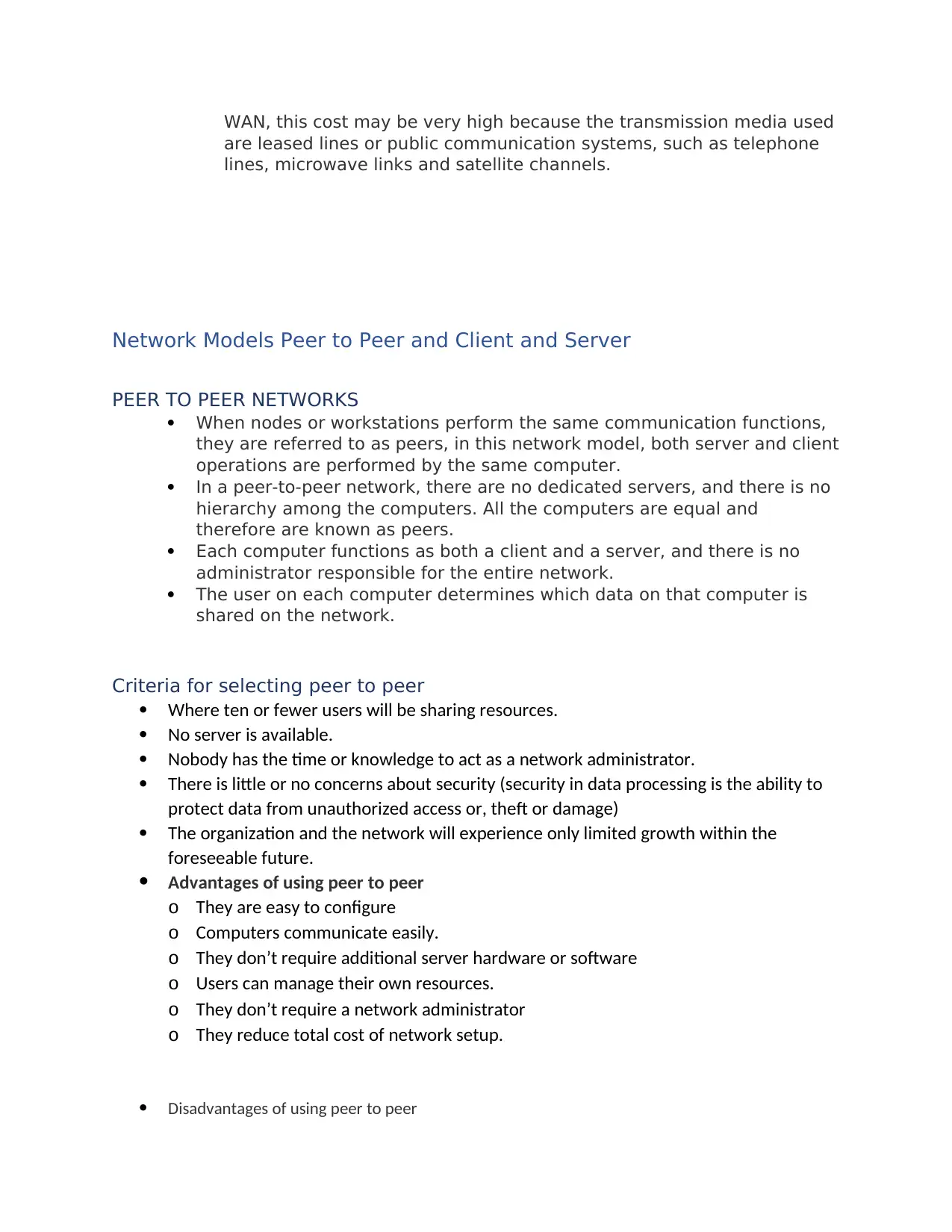
WAN, this cost may be very high because the transmission media used
are leased lines or public communication systems, such as telephone
lines, microwave links and satellite channels.
Network Models Peer to Peer and Client and Server
PEER TO PEER NETWORKS
When nodes or workstations perform the same communication functions,
they are referred to as peers, in this network model, both server and client
operations are performed by the same computer.
In a peer-to-peer network, there are no dedicated servers, and there is no
hierarchy among the computers. All the computers are equal and
therefore are known as peers.
Each computer functions as both a client and a server, and there is no
administrator responsible for the entire network.
The user on each computer determines which data on that computer is
shared on the network.
Criteria for selecting peer to peer
Where ten or fewer users will be sharing resources.
No server is available.
Nobody has the time or knowledge to act as a network administrator.
There is little or no concerns about security (security in data processing is the ability to
protect data from unauthorized access or, theft or damage)
The organization and the network will experience only limited growth within the
foreseeable future.
Advantages of using peer to peer
o They are easy to configure
o Computers communicate easily.
o They don’t require additional server hardware or software
o Users can manage their own resources.
o They don’t require a network administrator
o They reduce total cost of network setup.
Disadvantages of using peer to peer
are leased lines or public communication systems, such as telephone
lines, microwave links and satellite channels.
Network Models Peer to Peer and Client and Server
PEER TO PEER NETWORKS
When nodes or workstations perform the same communication functions,
they are referred to as peers, in this network model, both server and client
operations are performed by the same computer.
In a peer-to-peer network, there are no dedicated servers, and there is no
hierarchy among the computers. All the computers are equal and
therefore are known as peers.
Each computer functions as both a client and a server, and there is no
administrator responsible for the entire network.
The user on each computer determines which data on that computer is
shared on the network.
Criteria for selecting peer to peer
Where ten or fewer users will be sharing resources.
No server is available.
Nobody has the time or knowledge to act as a network administrator.
There is little or no concerns about security (security in data processing is the ability to
protect data from unauthorized access or, theft or damage)
The organization and the network will experience only limited growth within the
foreseeable future.
Advantages of using peer to peer
o They are easy to configure
o Computers communicate easily.
o They don’t require additional server hardware or software
o Users can manage their own resources.
o They don’t require a network administrator
o They reduce total cost of network setup.
Disadvantages of using peer to peer
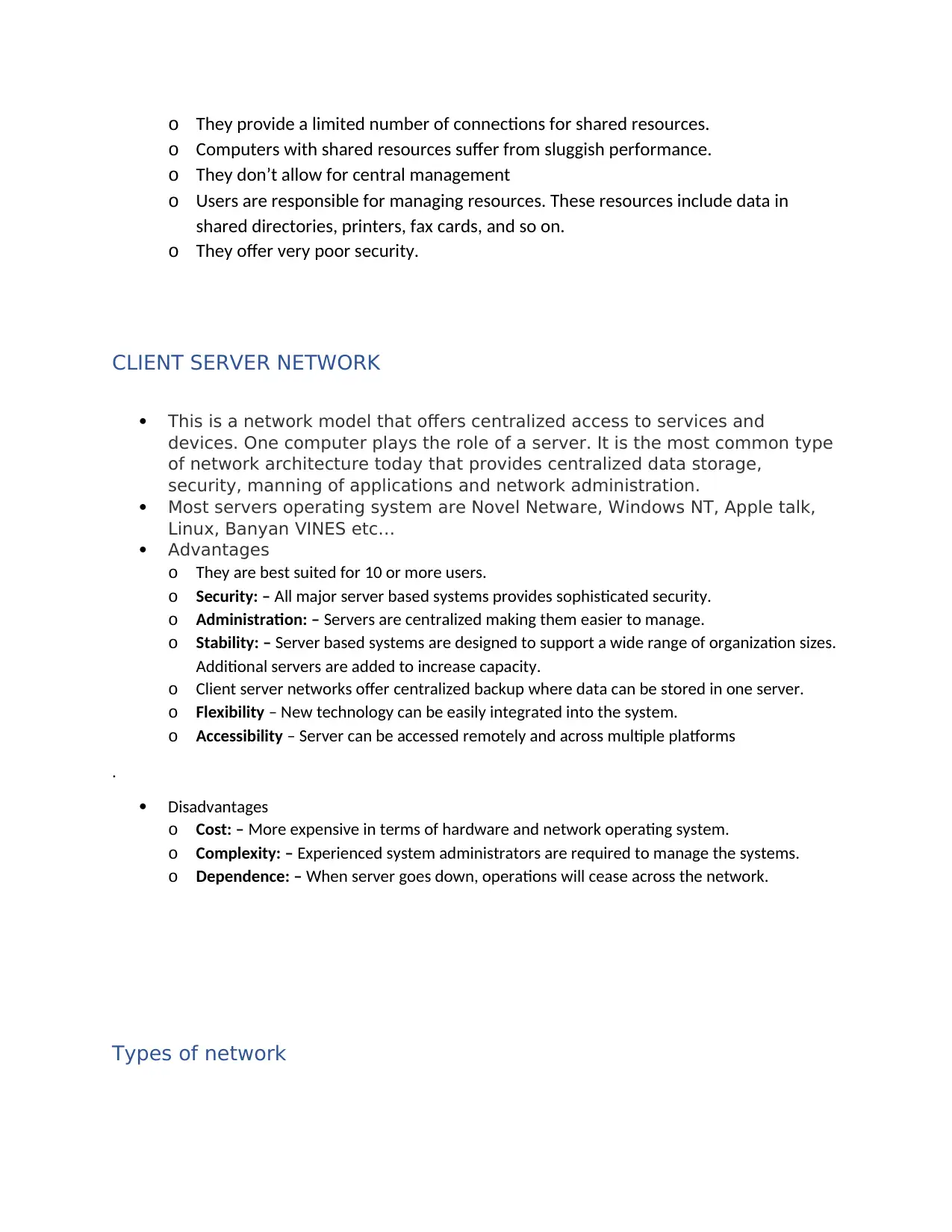
o They provide a limited number of connections for shared resources.
o Computers with shared resources suffer from sluggish performance.
o They don’t allow for central management
o Users are responsible for managing resources. These resources include data in
shared directories, printers, fax cards, and so on.
o They offer very poor security.
CLIENT SERVER NETWORK
This is a network model that offers centralized access to services and
devices. One computer plays the role of a server. It is the most common type
of network architecture today that provides centralized data storage,
security, manning of applications and network administration.
Most servers operating system are Novel Netware, Windows NT, Apple talk,
Linux, Banyan VINES etc…
Advantages
o They are best suited for 10 or more users.
o Security: – All major server based systems provides sophisticated security.
o Administration: – Servers are centralized making them easier to manage.
o Stability: – Server based systems are designed to support a wide range of organization sizes.
Additional servers are added to increase capacity.
o Client server networks offer centralized backup where data can be stored in one server.
o Flexibility – New technology can be easily integrated into the system.
o Accessibility – Server can be accessed remotely and across multiple platforms
.
Disadvantages
o Cost: – More expensive in terms of hardware and network operating system.
o Complexity: – Experienced system administrators are required to manage the systems.
o Dependence: – When server goes down, operations will cease across the network.
Types of network
o Computers with shared resources suffer from sluggish performance.
o They don’t allow for central management
o Users are responsible for managing resources. These resources include data in
shared directories, printers, fax cards, and so on.
o They offer very poor security.
CLIENT SERVER NETWORK
This is a network model that offers centralized access to services and
devices. One computer plays the role of a server. It is the most common type
of network architecture today that provides centralized data storage,
security, manning of applications and network administration.
Most servers operating system are Novel Netware, Windows NT, Apple talk,
Linux, Banyan VINES etc…
Advantages
o They are best suited for 10 or more users.
o Security: – All major server based systems provides sophisticated security.
o Administration: – Servers are centralized making them easier to manage.
o Stability: – Server based systems are designed to support a wide range of organization sizes.
Additional servers are added to increase capacity.
o Client server networks offer centralized backup where data can be stored in one server.
o Flexibility – New technology can be easily integrated into the system.
o Accessibility – Server can be accessed remotely and across multiple platforms
.
Disadvantages
o Cost: – More expensive in terms of hardware and network operating system.
o Complexity: – Experienced system administrators are required to manage the systems.
o Dependence: – When server goes down, operations will cease across the network.
Types of network
⊘ This is a preview!⊘
Do you want full access?
Subscribe today to unlock all pages.

Trusted by 1+ million students worldwide
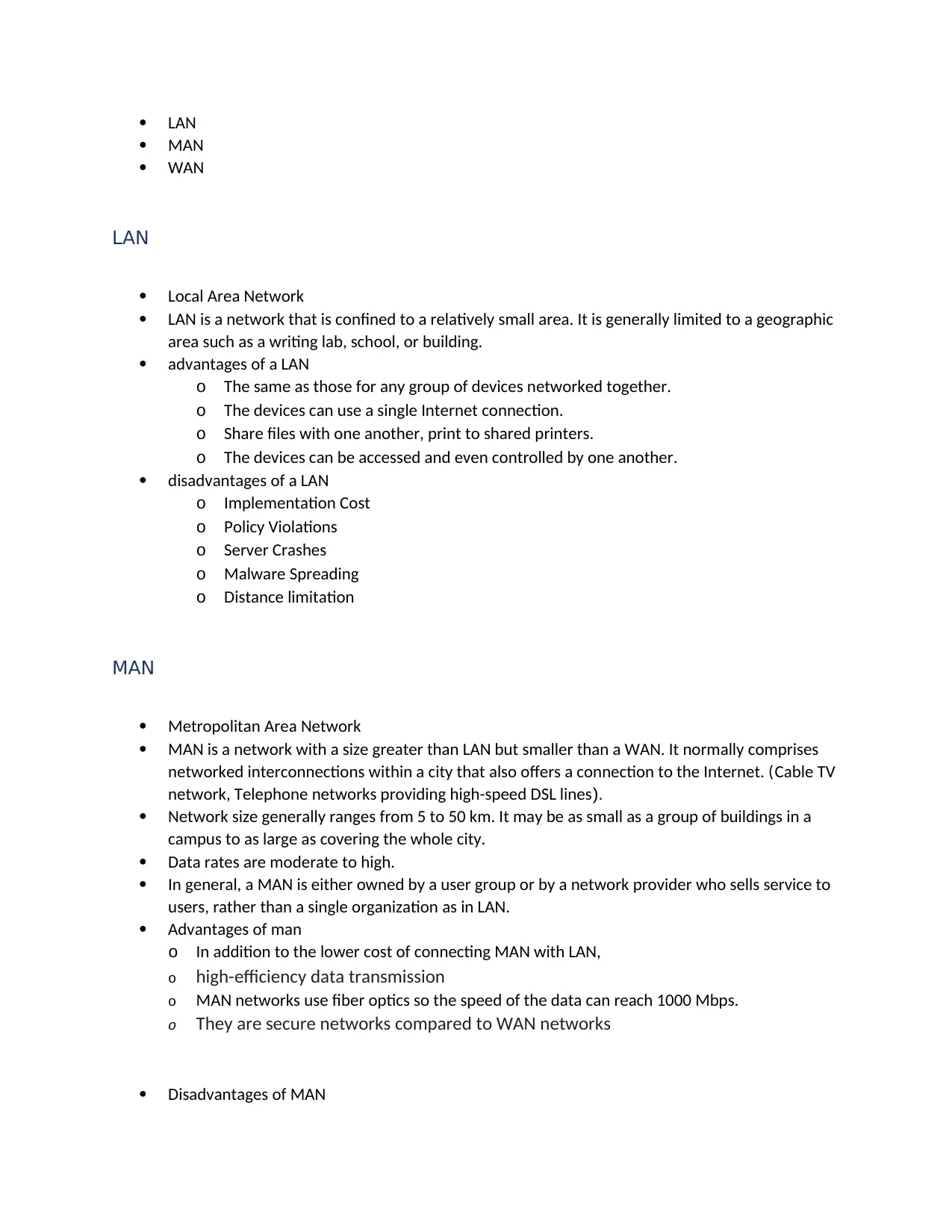
LAN
MAN
WAN
LAN
Local Area Network
LAN is a network that is confined to a relatively small area. It is generally limited to a geographic
area such as a writing lab, school, or building.
advantages of a LAN
o The same as those for any group of devices networked together.
o The devices can use a single Internet connection.
o Share files with one another, print to shared printers.
o The devices can be accessed and even controlled by one another.
disadvantages of a LAN
o Implementation Cost
o Policy Violations
o Server Crashes
o Malware Spreading
o Distance limitation
MAN
Metropolitan Area Network
MAN is a network with a size greater than LAN but smaller than a WAN. It normally comprises
networked interconnections within a city that also offers a connection to the Internet. (Cable TV
network, Telephone networks providing high-speed DSL lines).
Network size generally ranges from 5 to 50 km. It may be as small as a group of buildings in a
campus to as large as covering the whole city.
Data rates are moderate to high.
In general, a MAN is either owned by a user group or by a network provider who sells service to
users, rather than a single organization as in LAN.
Advantages of man
o In addition to the lower cost of connecting MAN with LAN,
o high-efficiency data transmission
o MAN networks use fiber optics so the speed of the data can reach 1000 Mbps.
o They are secure networks compared to WAN networks
Disadvantages of MAN
MAN
WAN
LAN
Local Area Network
LAN is a network that is confined to a relatively small area. It is generally limited to a geographic
area such as a writing lab, school, or building.
advantages of a LAN
o The same as those for any group of devices networked together.
o The devices can use a single Internet connection.
o Share files with one another, print to shared printers.
o The devices can be accessed and even controlled by one another.
disadvantages of a LAN
o Implementation Cost
o Policy Violations
o Server Crashes
o Malware Spreading
o Distance limitation
MAN
Metropolitan Area Network
MAN is a network with a size greater than LAN but smaller than a WAN. It normally comprises
networked interconnections within a city that also offers a connection to the Internet. (Cable TV
network, Telephone networks providing high-speed DSL lines).
Network size generally ranges from 5 to 50 km. It may be as small as a group of buildings in a
campus to as large as covering the whole city.
Data rates are moderate to high.
In general, a MAN is either owned by a user group or by a network provider who sells service to
users, rather than a single organization as in LAN.
Advantages of man
o In addition to the lower cost of connecting MAN with LAN,
o high-efficiency data transmission
o MAN networks use fiber optics so the speed of the data can reach 1000 Mbps.
o They are secure networks compared to WAN networks
Disadvantages of MAN
Paraphrase This Document
Need a fresh take? Get an instant paraphrase of this document with our AI Paraphraser
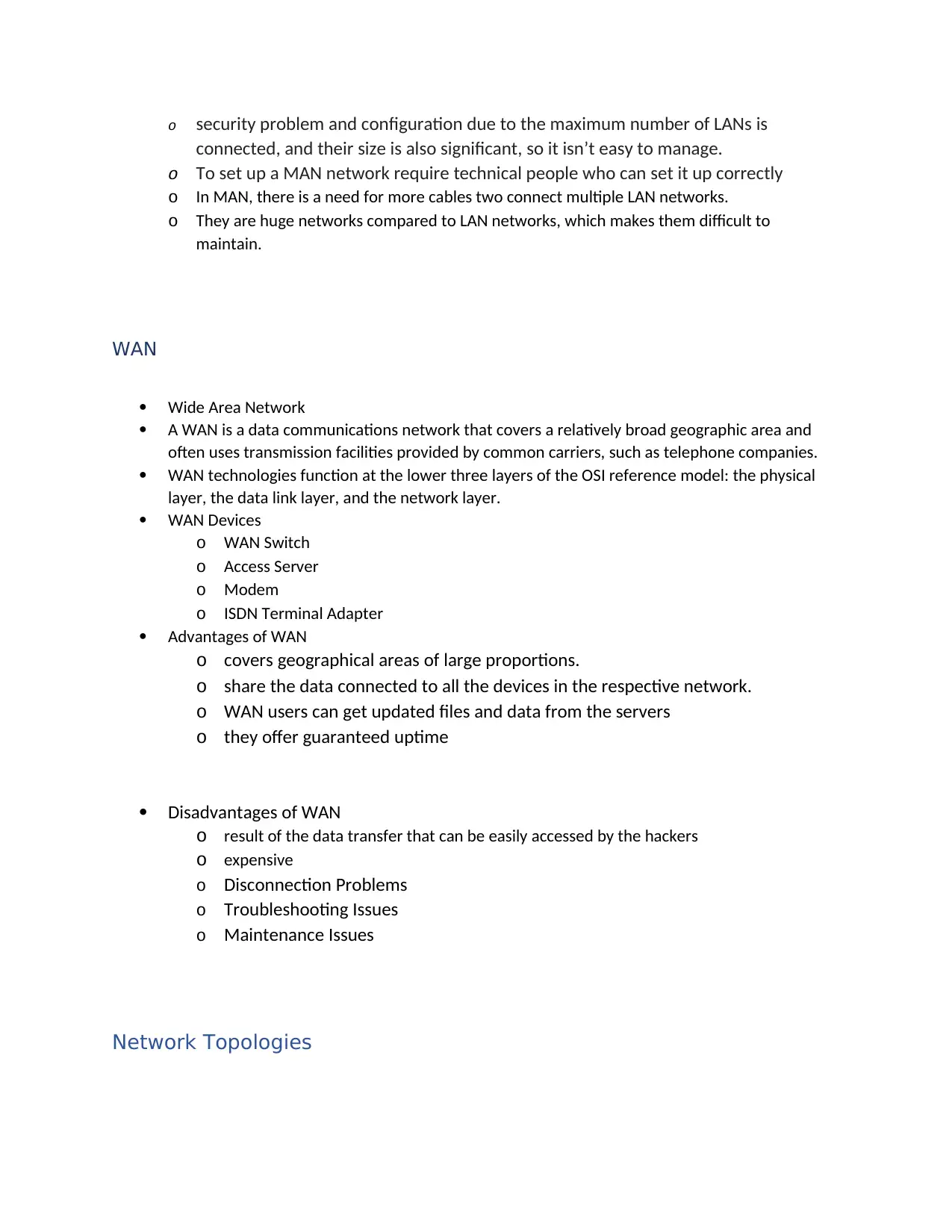
o security problem and configuration due to the maximum number of LANs is
connected, and their size is also significant, so it isn’t easy to manage.
o To set up a MAN network require technical people who can set it up correctly
o In MAN, there is a need for more cables two connect multiple LAN networks.
o They are huge networks compared to LAN networks, which makes them difficult to
maintain.
WAN
Wide Area Network
A WAN is a data communications network that covers a relatively broad geographic area and
often uses transmission facilities provided by common carriers, such as telephone companies.
WAN technologies function at the lower three layers of the OSI reference model: the physical
layer, the data link layer, and the network layer.
WAN Devices
o WAN Switch
o Access Server
o Modem
o ISDN Terminal Adapter
Advantages of WAN
o covers geographical areas of large proportions.
o share the data connected to all the devices in the respective network.
o WAN users can get updated files and data from the servers
o they offer guaranteed uptime
Disadvantages of WAN
o result of the data transfer that can be easily accessed by the hackers
o expensive
o Disconnection Problems
o Troubleshooting Issues
o Maintenance Issues
Network Topologies
connected, and their size is also significant, so it isn’t easy to manage.
o To set up a MAN network require technical people who can set it up correctly
o In MAN, there is a need for more cables two connect multiple LAN networks.
o They are huge networks compared to LAN networks, which makes them difficult to
maintain.
WAN
Wide Area Network
A WAN is a data communications network that covers a relatively broad geographic area and
often uses transmission facilities provided by common carriers, such as telephone companies.
WAN technologies function at the lower three layers of the OSI reference model: the physical
layer, the data link layer, and the network layer.
WAN Devices
o WAN Switch
o Access Server
o Modem
o ISDN Terminal Adapter
Advantages of WAN
o covers geographical areas of large proportions.
o share the data connected to all the devices in the respective network.
o WAN users can get updated files and data from the servers
o they offer guaranteed uptime
Disadvantages of WAN
o result of the data transfer that can be easily accessed by the hackers
o expensive
o Disconnection Problems
o Troubleshooting Issues
o Maintenance Issues
Network Topologies
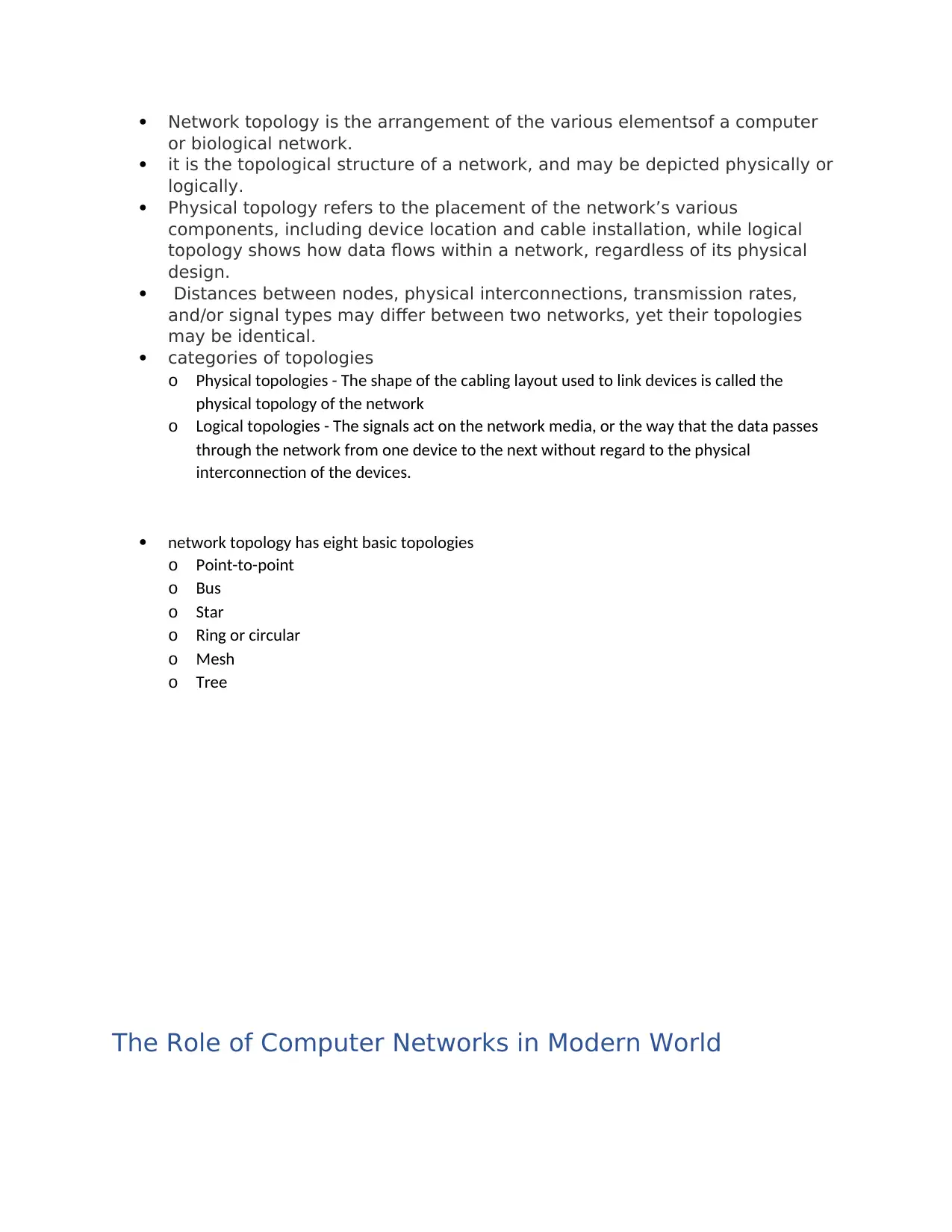
Network topology is the arrangement of the various elementsof a computer
or biological network.
it is the topological structure of a network, and may be depicted physically or
logically.
Physical topology refers to the placement of the network’s various
components, including device location and cable installation, while logical
topology shows how data flows within a network, regardless of its physical
design.
Distances between nodes, physical interconnections, transmission rates,
and/or signal types may differ between two networks, yet their topologies
may be identical.
categories of topologies
o Physical topologies - The shape of the cabling layout used to link devices is called the
physical topology of the network
o Logical topologies - The signals act on the network media, or the way that the data passes
through the network from one device to the next without regard to the physical
interconnection of the devices.
network topology has eight basic topologies
o Point-to-point
o Bus
o Star
o Ring or circular
o Mesh
o Tree
The Role of Computer Networks in Modern World
or biological network.
it is the topological structure of a network, and may be depicted physically or
logically.
Physical topology refers to the placement of the network’s various
components, including device location and cable installation, while logical
topology shows how data flows within a network, regardless of its physical
design.
Distances between nodes, physical interconnections, transmission rates,
and/or signal types may differ between two networks, yet their topologies
may be identical.
categories of topologies
o Physical topologies - The shape of the cabling layout used to link devices is called the
physical topology of the network
o Logical topologies - The signals act on the network media, or the way that the data passes
through the network from one device to the next without regard to the physical
interconnection of the devices.
network topology has eight basic topologies
o Point-to-point
o Bus
o Star
o Ring or circular
o Mesh
o Tree
The Role of Computer Networks in Modern World
⊘ This is a preview!⊘
Do you want full access?
Subscribe today to unlock all pages.

Trusted by 1+ million students worldwide
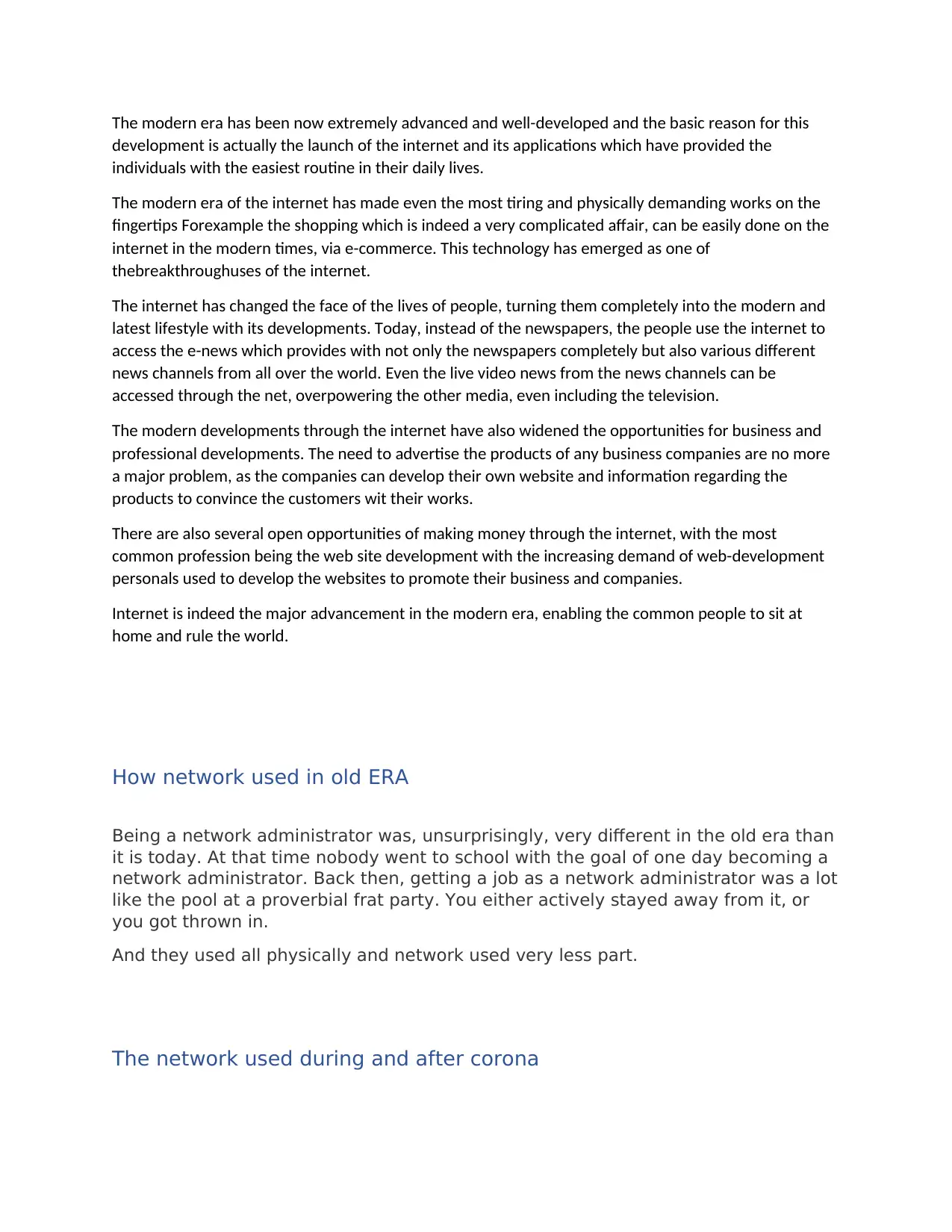
The modern era has been now extremely advanced and well-developed and the basic reason for this
development is actually the launch of the internet and its applications which have provided the
individuals with the easiest routine in their daily lives.
The modern era of the internet has made even the most tiring and physically demanding works on the
fingertips Forexample the shopping which is indeed a very complicated affair, can be easily done on the
internet in the modern times, via e-commerce. This technology has emerged as one of
thebreakthroughuses of the internet.
The internet has changed the face of the lives of people, turning them completely into the modern and
latest lifestyle with its developments. Today, instead of the newspapers, the people use the internet to
access the e-news which provides with not only the newspapers completely but also various different
news channels from all over the world. Even the live video news from the news channels can be
accessed through the net, overpowering the other media, even including the television.
The modern developments through the internet have also widened the opportunities for business and
professional developments. The need to advertise the products of any business companies are no more
a major problem, as the companies can develop their own website and information regarding the
products to convince the customers wit their works.
There are also several open opportunities of making money through the internet, with the most
common profession being the web site development with the increasing demand of web-development
personals used to develop the websites to promote their business and companies.
Internet is indeed the major advancement in the modern era, enabling the common people to sit at
home and rule the world.
How network used in old ERA
Being a network administrator was, unsurprisingly, very different in the old era than
it is today. At that time nobody went to school with the goal of one day becoming a
network administrator. Back then, getting a job as a network administrator was a lot
like the pool at a proverbial frat party. You either actively stayed away from it, or
you got thrown in.
And they used all physically and network used very less part.
The network used during and after corona
development is actually the launch of the internet and its applications which have provided the
individuals with the easiest routine in their daily lives.
The modern era of the internet has made even the most tiring and physically demanding works on the
fingertips Forexample the shopping which is indeed a very complicated affair, can be easily done on the
internet in the modern times, via e-commerce. This technology has emerged as one of
thebreakthroughuses of the internet.
The internet has changed the face of the lives of people, turning them completely into the modern and
latest lifestyle with its developments. Today, instead of the newspapers, the people use the internet to
access the e-news which provides with not only the newspapers completely but also various different
news channels from all over the world. Even the live video news from the news channels can be
accessed through the net, overpowering the other media, even including the television.
The modern developments through the internet have also widened the opportunities for business and
professional developments. The need to advertise the products of any business companies are no more
a major problem, as the companies can develop their own website and information regarding the
products to convince the customers wit their works.
There are also several open opportunities of making money through the internet, with the most
common profession being the web site development with the increasing demand of web-development
personals used to develop the websites to promote their business and companies.
Internet is indeed the major advancement in the modern era, enabling the common people to sit at
home and rule the world.
How network used in old ERA
Being a network administrator was, unsurprisingly, very different in the old era than
it is today. At that time nobody went to school with the goal of one day becoming a
network administrator. Back then, getting a job as a network administrator was a lot
like the pool at a proverbial frat party. You either actively stayed away from it, or
you got thrown in.
And they used all physically and network used very less part.
The network used during and after corona
Paraphrase This Document
Need a fresh take? Get an instant paraphrase of this document with our AI Paraphraser
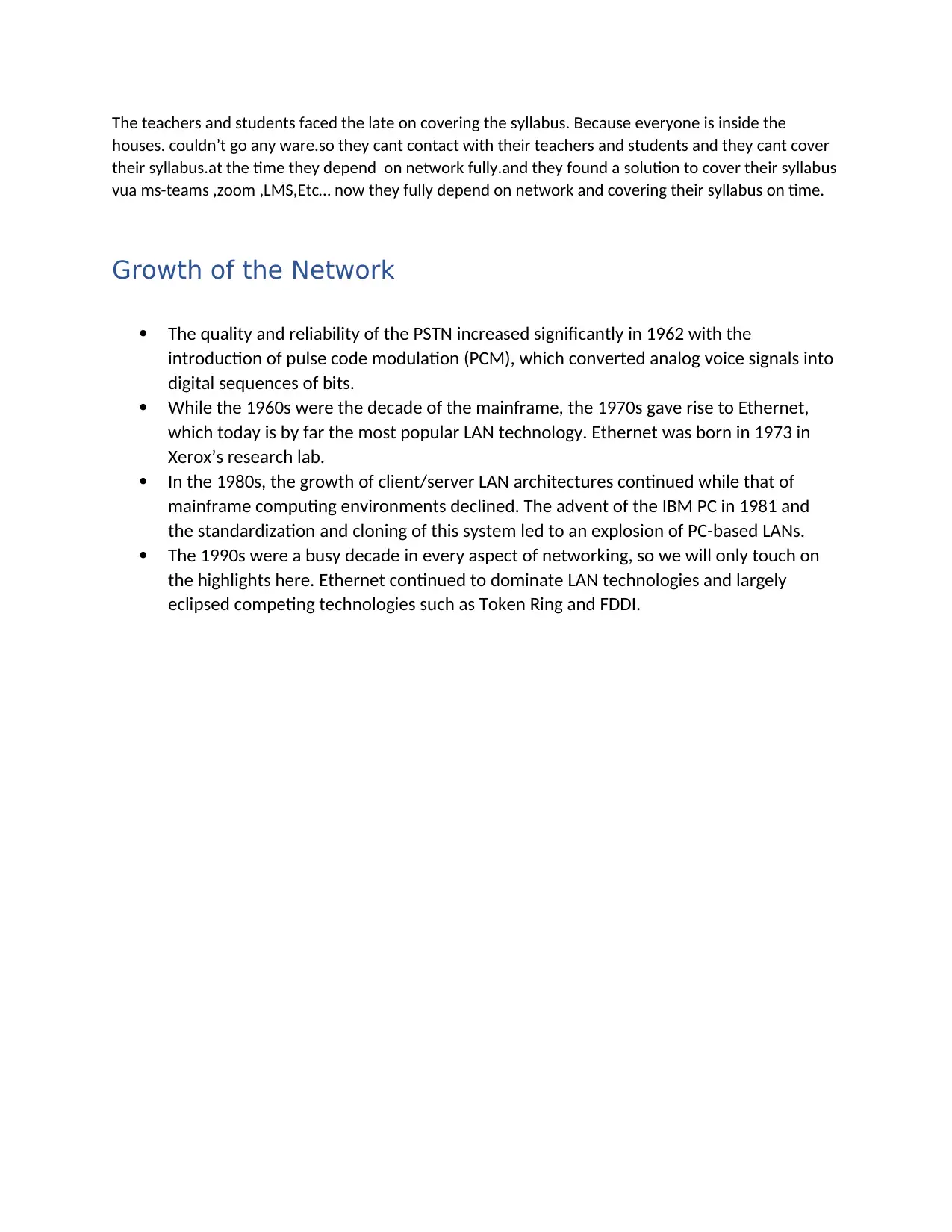
The teachers and students faced the late on covering the syllabus. Because everyone is inside the
houses. couldn’t go any ware.so they cant contact with their teachers and students and they cant cover
their syllabus.at the time they depend on network fully.and they found a solution to cover their syllabus
vua ms-teams ,zoom ,LMS,Etc… now they fully depend on network and covering their syllabus on time.
Growth of the Network
The quality and reliability of the PSTN increased significantly in 1962 with the
introduction of pulse code modulation (PCM), which converted analog voice signals into
digital sequences of bits.
While the 1960s were the decade of the mainframe, the 1970s gave rise to Ethernet,
which today is by far the most popular LAN technology. Ethernet was born in 1973 in
Xerox’s research lab.
In the 1980s, the growth of client/server LAN architectures continued while that of
mainframe computing environments declined. The advent of the IBM PC in 1981 and
the standardization and cloning of this system led to an explosion of PC-based LANs.
The 1990s were a busy decade in every aspect of networking, so we will only touch on
the highlights here. Ethernet continued to dominate LAN technologies and largely
eclipsed competing technologies such as Token Ring and FDDI.
houses. couldn’t go any ware.so they cant contact with their teachers and students and they cant cover
their syllabus.at the time they depend on network fully.and they found a solution to cover their syllabus
vua ms-teams ,zoom ,LMS,Etc… now they fully depend on network and covering their syllabus on time.
Growth of the Network
The quality and reliability of the PSTN increased significantly in 1962 with the
introduction of pulse code modulation (PCM), which converted analog voice signals into
digital sequences of bits.
While the 1960s were the decade of the mainframe, the 1970s gave rise to Ethernet,
which today is by far the most popular LAN technology. Ethernet was born in 1973 in
Xerox’s research lab.
In the 1980s, the growth of client/server LAN architectures continued while that of
mainframe computing environments declined. The advent of the IBM PC in 1981 and
the standardization and cloning of this system led to an explosion of PC-based LANs.
The 1990s were a busy decade in every aspect of networking, so we will only touch on
the highlights here. Ethernet continued to dominate LAN technologies and largely
eclipsed competing technologies such as Token Ring and FDDI.
1 out of 11
Related Documents
Your All-in-One AI-Powered Toolkit for Academic Success.
+13062052269
info@desklib.com
Available 24*7 on WhatsApp / Email
![[object Object]](/_next/static/media/star-bottom.7253800d.svg)
Unlock your academic potential
Copyright © 2020–2025 A2Z Services. All Rights Reserved. Developed and managed by ZUCOL.





